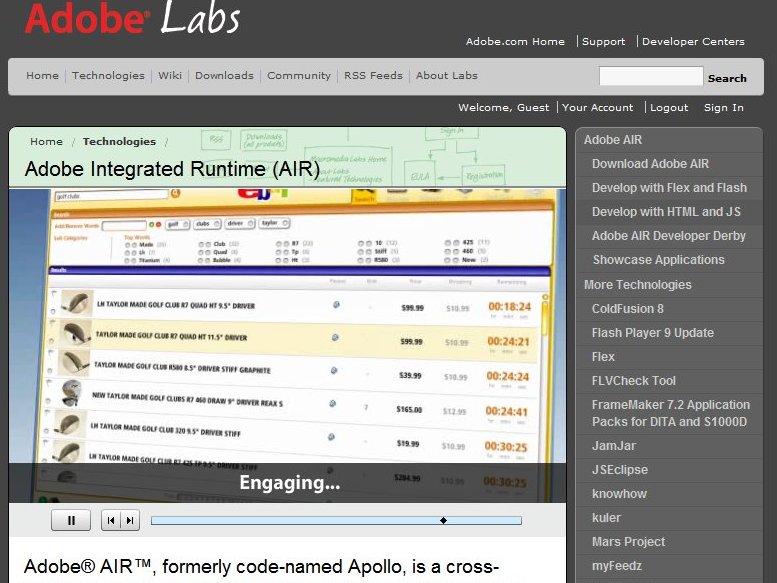Adobe's dream of the next-gen interactive web
New web authoring framework follows in Flash footsteps

Adobe has lifted the lid on AIR, the creative software giant's next-generation Rich Internet Application (RIA) framework, which it hopes will succeed Flash as one of the cornerstones of the interactive Web.
Formally named Apollo, Adobe's newest innovation stands for Adobe Integrated Runtime and its rebranding as AIR coincides with its launch as a full public beta earlier this month.
Like Flash, AIR is cross-platform, intended to allow developers to implement their existing web skills in building and deploying RIAs - to the desktop as well as within the browser window.
In short, this means the same kind of user experience we've become used to via Flash running directly within our OS rather than a browser window. There are already a number of AIR devised desktop widgets and add-ons floating about the net - mostly from Adobe themselves keen to flaunt its newest technology.
Proof in the pudding
Some of these are hit-and-miss. For example ScreenPlay is a nice idea but utterly impractical; it's premise being it allows you to highlight, mark-up or just plain squiggle all over your desktop as with a variety of pens. In practice though, it completely defeats the point of having a fluid and moveable desktop where resizing, moving and tabbing through windows is the norm.
That said, within Adobe's Labs showcase you'll find apps that utilise the AIR runtime such as MyMovieWatch (a great movie tracker that syncs with your NetFlicks or Amazon account) and Adobe's own Kuler widget; itself a very professional colour picker tool that allows you to save, upload and share any colour schemes you might have created directly to the Kuler site.
Writing on his widely respected blog , John C Bland II, CEO and chief developer for JDEV Inc ., appears genuinely excited by the concept of AIR - and as a new media developer his opinions are worth noting: "One of the greatest abilities of AIR, in my opinion, is the ability to create an application to run online and offline," he writes. "The application could allow the user to make changes to their account, content, etc. while not connected and sync the data online when the connection returns. The user will only love the application even more."
Get daily insight, inspiration and deals in your inbox
Sign up for breaking news, reviews, opinion, top tech deals, and more.
Developer details
In terms of development, Adobe has been careful to ensure support is as widespread as possible. AIR is, at its most basic level, an extension of the existing Flex SDK app. That means anything that authors Flex supports authoring of AIR apps. Unlike Flash and Flex, though, there is no IDE (Integrated Development Environment) for AIR. You develop in your favoured native environment and can run anything that produces a Flash (SWF) or HTML file as an AIR app.
Currently HTML and JavaScript developed for AIR are handled by the WebKit HTML and JavaScript engine, while SWF files are produced by Flex and Flash. There are no plans for a Linux release until the new Flash player is finalised.
Importantly, Adobe's latest Creative Suite 3 includes support in both Dreamweaver CS3 and Flash CS3. The former requires a small developer kit install, the upshot of which means developers can use their existing HTML skills to author desktop apps or browser-based apps.
Development of apps seems remarkably straightforward. Developers - according to Adobe - need simply repackage a Flash, Dreamweaver or Flex-developed app for the AIR runtime. Dave Gruber, group product marketing manager for Flex at Adobe, says it's this simplicity which will ensure AIR's uptake is in the same vein as Flash's: "[AIR] opens up a whole new set of capabilities that can be done on the desktop that couldn't be done in a browser," says Gruber.
From browser to desktop and back
Ray Valdes, research director for Gartner , thinks Adobe is taking the right steps. "There needs to be reduced discontinuity between browser and desktop apps through common programming models and tools. I would worry if Adobe were not doing these things because all of these things are needed," he told internetnews.com .
He went on to note that while Adobe is moving from the browser to the desktop, Microsoft is moving in the opposite direction with Silverlight.
"That of course means a collision course. I think in some sense it's all good in that there are more choices for the developer and the user. I think that anyone who wants to compete will need to execute well, look at competitor offerings, realize it's a dynamic space and [that] everything is a moving target."
So will AIR become the next cornerstone of the Web? If penetration is anywhere near as widespread as the Flash runtime, then half of Adobe's battle is won. The more important crusade will be that of developers creating apps which users actually want and can make use of. Tom Dennis
Dan (Twitter, Google+) is TechRadar's Former Deputy Editor and is now in charge at our sister site T3.com. Covering all things computing, internet and mobile he's a seasoned regular at major tech shows such as CES, IFA and Mobile World Congress. Dan has also been a tech expert for many outlets including BBC Radio 4, 5Live and the World Service, The Sun and ITV News.